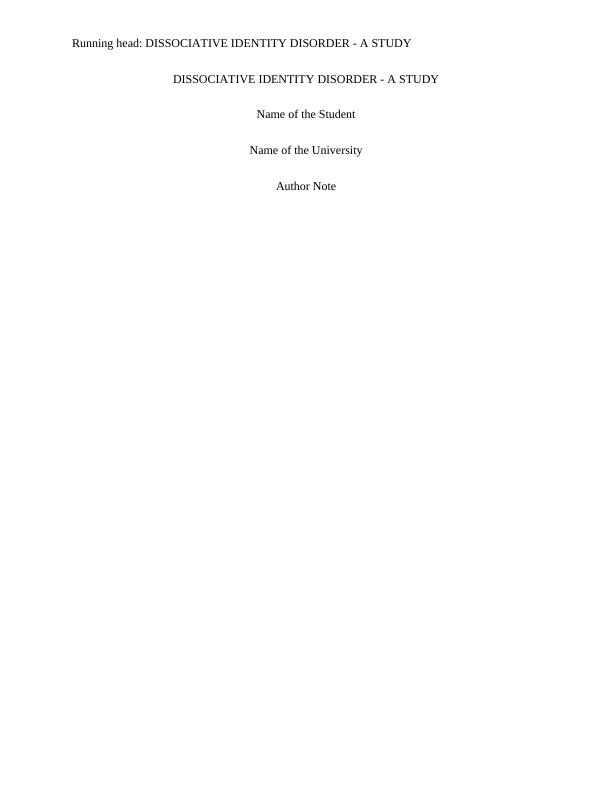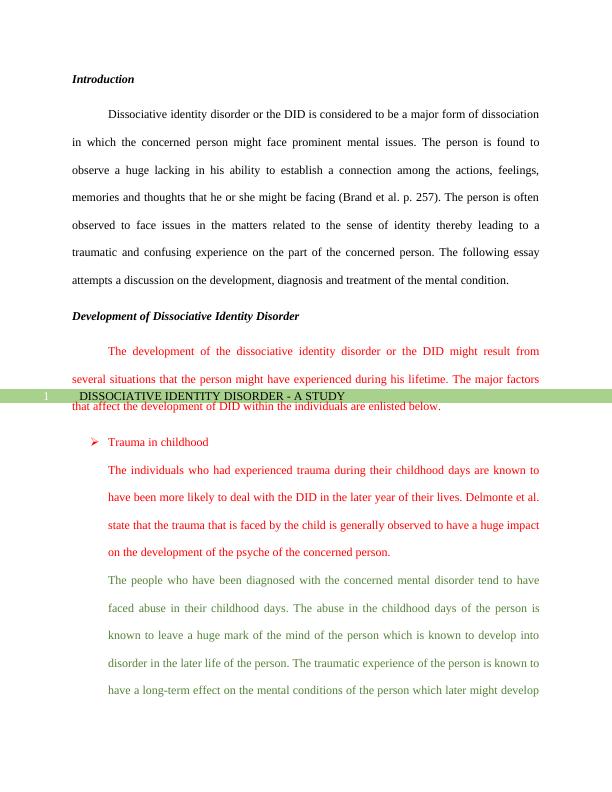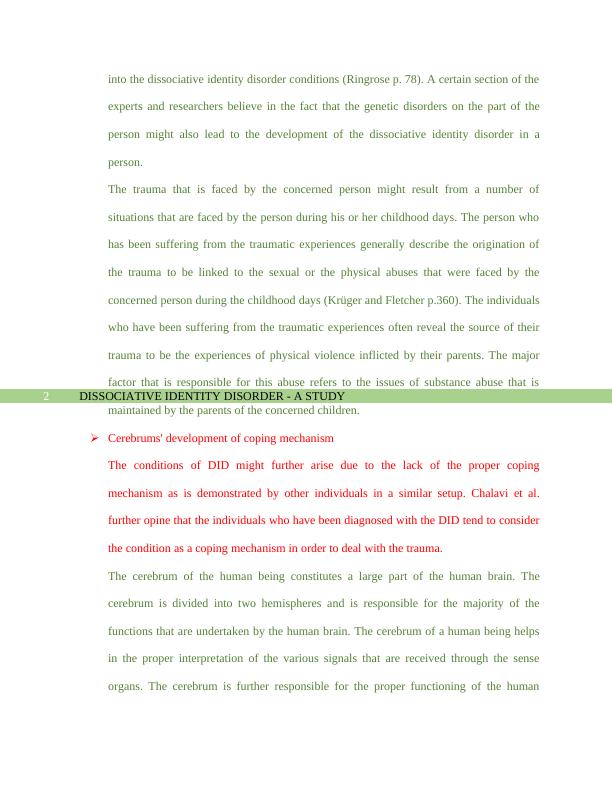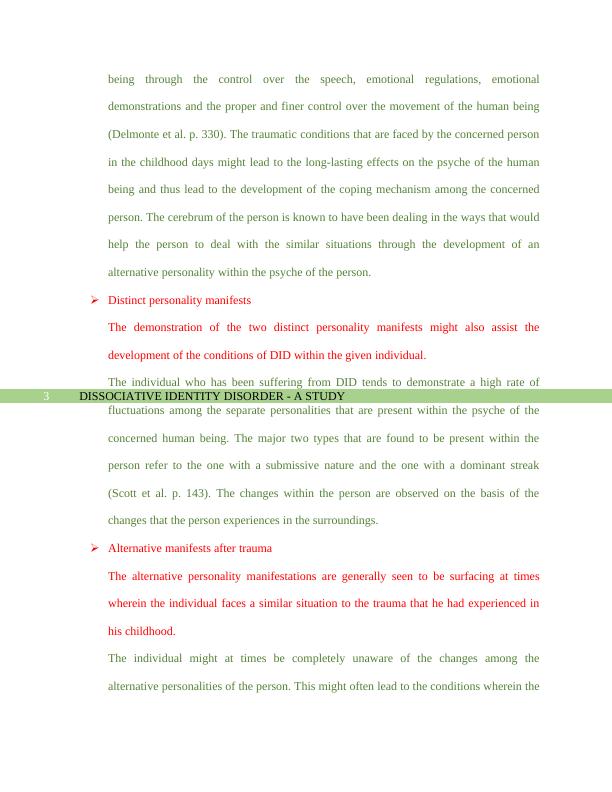Dissociative Identity Disorder - A Study
Added on 2022-12-15
11 Pages2820 Words342 Views
Running head: DISSOCIATIVE IDENTITY DISORDER - A STUDY
DISSOCIATIVE IDENTITY DISORDER - A STUDY
Name of the Student
Name of the University
Author Note
DISSOCIATIVE IDENTITY DISORDER - A STUDY
Name of the Student
Name of the University
Author Note

DISSOCIATIVE IDENTITY DISORDER - A STUDY1
Introduction
Dissociative identity disorder or the DID is considered to be a major form of dissociation
in which the concerned person might face prominent mental issues. The person is found to
observe a huge lacking in his ability to establish a connection among the actions, feelings,
memories and thoughts that he or she might be facing (Brand et al. p. 257). The person is often
observed to face issues in the matters related to the sense of identity thereby leading to a
traumatic and confusing experience on the part of the concerned person. The following essay
attempts a discussion on the development, diagnosis and treatment of the mental condition.
Development of Dissociative Identity Disorder
The development of the dissociative identity disorder or the DID might result from
several situations that the person might have experienced during his lifetime. The major factors
that affect the development of DID within the individuals are enlisted below.
Trauma in childhood
The individuals who had experienced trauma during their childhood days are known to
have been more likely to deal with the DID in the later year of their lives. Delmonte et al.
state that the trauma that is faced by the child is generally observed to have a huge impact
on the development of the psyche of the concerned person.
The people who have been diagnosed with the concerned mental disorder tend to have
faced abuse in their childhood days. The abuse in the childhood days of the person is
known to leave a huge mark of the mind of the person which is known to develop into
disorder in the later life of the person. The traumatic experience of the person is known to
have a long-term effect on the mental conditions of the person which later might develop
Introduction
Dissociative identity disorder or the DID is considered to be a major form of dissociation
in which the concerned person might face prominent mental issues. The person is found to
observe a huge lacking in his ability to establish a connection among the actions, feelings,
memories and thoughts that he or she might be facing (Brand et al. p. 257). The person is often
observed to face issues in the matters related to the sense of identity thereby leading to a
traumatic and confusing experience on the part of the concerned person. The following essay
attempts a discussion on the development, diagnosis and treatment of the mental condition.
Development of Dissociative Identity Disorder
The development of the dissociative identity disorder or the DID might result from
several situations that the person might have experienced during his lifetime. The major factors
that affect the development of DID within the individuals are enlisted below.
Trauma in childhood
The individuals who had experienced trauma during their childhood days are known to
have been more likely to deal with the DID in the later year of their lives. Delmonte et al.
state that the trauma that is faced by the child is generally observed to have a huge impact
on the development of the psyche of the concerned person.
The people who have been diagnosed with the concerned mental disorder tend to have
faced abuse in their childhood days. The abuse in the childhood days of the person is
known to leave a huge mark of the mind of the person which is known to develop into
disorder in the later life of the person. The traumatic experience of the person is known to
have a long-term effect on the mental conditions of the person which later might develop

DISSOCIATIVE IDENTITY DISORDER - A STUDY2
into the dissociative identity disorder conditions (Ringrose p. 78). A certain section of the
experts and researchers believe in the fact that the genetic disorders on the part of the
person might also lead to the development of the dissociative identity disorder in a
person.
The trauma that is faced by the concerned person might result from a number of
situations that are faced by the person during his or her childhood days. The person who
has been suffering from the traumatic experiences generally describe the origination of
the trauma to be linked to the sexual or the physical abuses that were faced by the
concerned person during the childhood days (Krüger and Fletcher p.360). The individuals
who have been suffering from the traumatic experiences often reveal the source of their
trauma to be the experiences of physical violence inflicted by their parents. The major
factor that is responsible for this abuse refers to the issues of substance abuse that is
maintained by the parents of the concerned children.
Cerebrums' development of coping mechanism
The conditions of DID might further arise due to the lack of the proper coping
mechanism as is demonstrated by other individuals in a similar setup. Chalavi et al.
further opine that the individuals who have been diagnosed with the DID tend to consider
the condition as a coping mechanism in order to deal with the trauma.
The cerebrum of the human being constitutes a large part of the human brain. The
cerebrum is divided into two hemispheres and is responsible for the majority of the
functions that are undertaken by the human brain. The cerebrum of a human being helps
in the proper interpretation of the various signals that are received through the sense
organs. The cerebrum is further responsible for the proper functioning of the human
into the dissociative identity disorder conditions (Ringrose p. 78). A certain section of the
experts and researchers believe in the fact that the genetic disorders on the part of the
person might also lead to the development of the dissociative identity disorder in a
person.
The trauma that is faced by the concerned person might result from a number of
situations that are faced by the person during his or her childhood days. The person who
has been suffering from the traumatic experiences generally describe the origination of
the trauma to be linked to the sexual or the physical abuses that were faced by the
concerned person during the childhood days (Krüger and Fletcher p.360). The individuals
who have been suffering from the traumatic experiences often reveal the source of their
trauma to be the experiences of physical violence inflicted by their parents. The major
factor that is responsible for this abuse refers to the issues of substance abuse that is
maintained by the parents of the concerned children.
Cerebrums' development of coping mechanism
The conditions of DID might further arise due to the lack of the proper coping
mechanism as is demonstrated by other individuals in a similar setup. Chalavi et al.
further opine that the individuals who have been diagnosed with the DID tend to consider
the condition as a coping mechanism in order to deal with the trauma.
The cerebrum of the human being constitutes a large part of the human brain. The
cerebrum is divided into two hemispheres and is responsible for the majority of the
functions that are undertaken by the human brain. The cerebrum of a human being helps
in the proper interpretation of the various signals that are received through the sense
organs. The cerebrum is further responsible for the proper functioning of the human

DISSOCIATIVE IDENTITY DISORDER - A STUDY3
being through the control over the speech, emotional regulations, emotional
demonstrations and the proper and finer control over the movement of the human being
(Delmonte et al. p. 330). The traumatic conditions that are faced by the concerned person
in the childhood days might lead to the long-lasting effects on the psyche of the human
being and thus lead to the development of the coping mechanism among the concerned
person. The cerebrum of the person is known to have been dealing in the ways that would
help the person to deal with the similar situations through the development of an
alternative personality within the psyche of the person.
Distinct personality manifests
The demonstration of the two distinct personality manifests might also assist the
development of the conditions of DID within the given individual.
The individual who has been suffering from DID tends to demonstrate a high rate of
fluctuations among the separate personalities that are present within the psyche of the
concerned human being. The major two types that are found to be present within the
person refer to the one with a submissive nature and the one with a dominant streak
(Scott et al. p. 143). The changes within the person are observed on the basis of the
changes that the person experiences in the surroundings.
Alternative manifests after trauma
The alternative personality manifestations are generally seen to be surfacing at times
wherein the individual faces a similar situation to the trauma that he had experienced in
his childhood.
The individual might at times be completely unaware of the changes among the
alternative personalities of the person. This might often lead to the conditions wherein the
being through the control over the speech, emotional regulations, emotional
demonstrations and the proper and finer control over the movement of the human being
(Delmonte et al. p. 330). The traumatic conditions that are faced by the concerned person
in the childhood days might lead to the long-lasting effects on the psyche of the human
being and thus lead to the development of the coping mechanism among the concerned
person. The cerebrum of the person is known to have been dealing in the ways that would
help the person to deal with the similar situations through the development of an
alternative personality within the psyche of the person.
Distinct personality manifests
The demonstration of the two distinct personality manifests might also assist the
development of the conditions of DID within the given individual.
The individual who has been suffering from DID tends to demonstrate a high rate of
fluctuations among the separate personalities that are present within the psyche of the
concerned human being. The major two types that are found to be present within the
person refer to the one with a submissive nature and the one with a dominant streak
(Scott et al. p. 143). The changes within the person are observed on the basis of the
changes that the person experiences in the surroundings.
Alternative manifests after trauma
The alternative personality manifestations are generally seen to be surfacing at times
wherein the individual faces a similar situation to the trauma that he had experienced in
his childhood.
The individual might at times be completely unaware of the changes among the
alternative personalities of the person. This might often lead to the conditions wherein the

End of preview
Want to access all the pages? Upload your documents or become a member.
Related Documents
Understanding Dissociative Identity Disorder: Phenomenology and Inner Experiencelg...
|11
|2812
|484
Best Treatment for Dissociative Identity Disorderlg...
|4
|850
|62
NRS2342 Essay on Mental Health Nursinglg...
|10
|2639
|361
Dissociative Identity Disorder and Psychosomatic Conditionslg...
|9
|2622
|81
Physchology Name Institution Professor Course Date.lg...
|12
|2632
|93
Mental Health | Post Trauma Stress Disorderlg...
|8
|2362
|16
